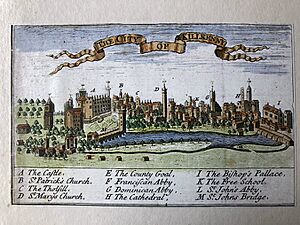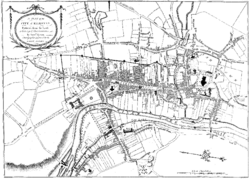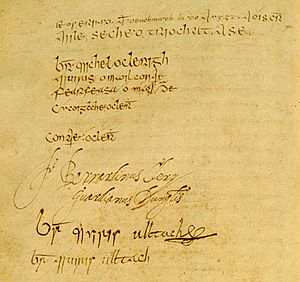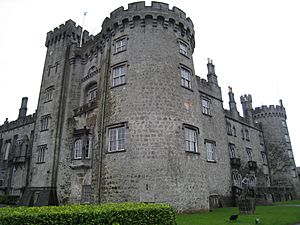History of Kilkenny facts for kids
The story of Kilkenny (which means "Cell or church of Canice" in Irish) began a long, long time ago. Around the 500s, a church was built here to honor St. Canice, who is now remembered by St. Canice's Cathedral. This area became a very important religious center. The first time Kilkenny was mentioned in old records was in 1085. But even before that, people lived here during the Stone Age and Bronze Age. We learn about Kilkenny's past from old newspapers, photos, letters, and things found by archaeologists.
The ancient Kings of Ossory lived near Kilkenny. Later, the main church for the Ossory area moved to Kilkenny. After the Norman invasion of Ireland, a powerful Norman leader named Richard Strongbow built a castle near where Kilkenny Castle is today. Another important Norman, William Marshall, helped Kilkenny grow into a town and built walls to protect its people. By the late 1200s, Kilkenny was controlled by the Normans and Irish who had mixed together. The old church area became known as Irishtown, and the new Norman town inside the walls was called Hightown.
A terrible sickness called the Black Death hit Kilkenny in 1348, affecting the Norman-Irish people greatly. To try and stop the Norman way of life from disappearing, special rules called the Statutes of Kilkenny were made in 1367. In 1609, King James I made Kilkenny a city. Later, during the Rebellion of 1641, a group called the "Confederation of Kilkenny" was based here until 1649. James II of England even stayed in Kilkenny Castle for a few months in 1689-1690.
In more recent times, the Kilkenny Design Workshops opened in 1965. In 1967, Kilkenny Castle was given to the people of Kilkenny. Today, Kilkenny is famous for its lively arts scene, with big events like the Kilkenny Arts Week Festival and the Cat Laughs Comedy Festival. People sometimes call Kilkenny the Marble City because of the local stone. People from Kilkenny are often called "Cats"!
| Historical population | ||
|---|---|---|
| Year | Pop. | ±% |
| 1821 | 23,230 | — |
| 1831 | 23,741 | +2.2% |
| 1841 | 19,071 | −19.7% |
| 1851 | 15,257 | −20.0% |
| 1861 | 13,235 | −13.3% |
| 1871 | 12,710 | −4.0% |
| 1881 | 12,299 | −3.2% |
| 1891 | 11,048 | −10.2% |
| 1901 | 10,609 | −4.0% |
| 1911 | 19,514 | +83.9% |
| 1926 | 10,046 | −48.5% |
| 1936 | 10,237 | +1.9% |
| 1946 | 10,291 | +0.5% |
| 1951 | 10,572 | +2.7% |
| 1956 | 12,328 | +16.6% |
| 1961 | 12,081 | −2.0% |
| 1966 | 12,030 | −0.4% |
| 1971 | 13,306 | +10.6% |
| 1981 | 16,886 | +26.9% |
| 1986 | 17,517 | +3.7% |
| 1991 | 17,669 | +0.9% |
| 1996 | 18,696 | +5.8% |
| 2002 | 20,735 | +10.9% |
| 2006 | 22,179 | +7.0% |
Contents
Ancient History of Kilkenny
Long before cities, people lived in the Kilkenny area. Evidence shows that people settled here on and off during the Stone Age (Mesolithic period) and the Bronze Age.
Early Christian Kilkenny
The name Kilkenny comes from the Irish words Cill Chainnigh, which means "Church of Canice". This name refers to a church built to honor St. Canice. This church was on the hill where St. Canice's Cathedral and a tall round tower stand today. This seems to be where the first big settlement in the area began. The old round tower shows that a church was built in Kilkenny very early on.
One old record, the Annals of the Four Masters, mentioned Kilkenny in 1085. Before this, the area was known as Osraighe. The entry in the Four Masters was the first time the main town was called Ceall-Cainnigh (which became Kilkenny). Even though it wasn't mentioned in earlier records, Kilkenny was a major religious center from at least the 700s. The Kings of Osraige also lived there. The main church for the Ossory area eventually moved from Aghaboe to Kilkenny.
Medieval Kilkenny (1169—1541)
Kilkenny became part of the Lordship of Leinster after the Norman invasion of Ireland around 1169-1171. Richard Strongbow, a powerful Norman leader, became Lord of Leinster in 1171. In 1172, Strongbow built the first castle, a wooden fort, near where Kilkenny Castle is now. This might have been on the site of an older home of the Irish Mac Gilla Pátraic family. The Normans then started building more forts, walls, and a town. In 1173, Irish clans tried to fight back and destroyed Strongbow's wooden fort.
In 1189, King Richard I arranged for William Marshal, 1st Earl of Pembroke to marry Strongbow's daughter, Isabel. William Marshall became Lord of Leinster in 1192 and made many improvements to his wife's lands, including Kilkenny. A big building project started in Kilkenny. In 1195, William Marshall rebuilt the fort in Kilkenny. This fort was later rebuilt as the stone Kilkenny Castle in the 1200s.
Work on St. Canice's Cathedral began in 1202. Some historians believe this is when the main church for the Ossory area moved to Kilkenny. The first stone castle at Kilkenny Castle was started in 1204 by William Marshall and finished in 1213. In 1207, William Marshall gave special rights to the town, and it grew northwards towards the River Breagagh.
Kilkenny had two main parts: Irishtown and Hightown. The original church area around St. Canice's Cathedral was called Irishtown and belonged to the bishop. The new Norman town inside the walls was called Hightown. Hightown was set up by William Marshall. Walls were built to protect the people living in the town.
Witchcraft Accusations
In 1320, something unusual happened in Kilkenny. A wealthy woman named Dame Alice Kyteler was accused of witchcraft. This was one of the first times someone was accused of witchcraft in Ireland and one of the earliest such accusations in Europe. It was also the first time women accused of witchcraft were seen as an organized group. While serious punishments for witchcraft became more common later, in Kilkenny, Alice's maidservant, Petronilla de Meath, was publicly punished.
Dame Alice Kyteler was born around 1280 into a well-known family in Kilkenny. She was married four times, and each of her husbands died. After her last husband passed away, her children accused her of using magic and poison to get his money. The case went before the Bishop of Ossory, Richard de Ledrede. The bishop believed Alice and her followers had turned away from their faith. He tried to have Alice arrested, but Alice's brother-in-law, who was also a powerful official, put the bishop in prison instead! After being released, the bishop continued to pursue Alice's maidservant, Petronilla. It is thought that Alice and Petronilla's daughter escaped to England. Petronilla was then forced to say publicly that Alice and her group were guilty of witchcraft. She claimed that she and Alice used a special ointment to make a wooden beam fly.
The Black Death and Statutes of Kilkenny
The terrible sickness known as the Black Death reached Kilkenny in 1348. It hit the English and Norman people in towns and villages much harder than the native Irish, who lived in more spread-out country areas.
A monk named John Clyn from Kilkenny wrote about the plague in 1348. He described how quickly people died:
The sickness grew strong in Kilkenny during Lent, for between Christmas day and March 6, eight Friars Preachers died. There was hardly a house where only one person died, but usually husband and wife with their children and family all died together.
The plague was a disaster for the English settlements. After it passed, the Irish language and customs became stronger again. The area controlled by the English became much smaller, mostly just around Dublin.
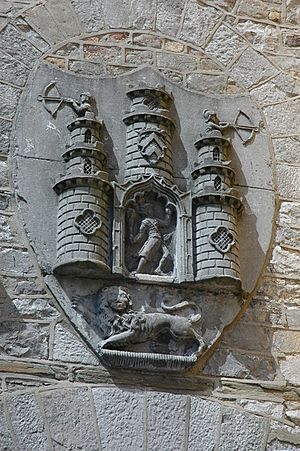
To try and stop the English way of life from disappearing, a set of thirty-five rules called the Statutes of Kilkenny were passed in Kilkenny in 1367. By the mid-1200s, the English in Ireland felt their way of life was in danger. Many English settlers were starting to adopt Irish laws, customs, clothes, and language. People even said they were "more Irish than the Irish themselves"!
The introduction to the Statutes said:
"now many English of the said land, forsaking the English language, manners, mode of riding, laws and usages, live and govern themselves according to the manners, fashion, and language of the Irish enemies; and also have made divers marriages and alliances between themselves and the Irish enemies aforesaid; whereby the said land, and the liege people thereof, the English language, the allagiance due to our lord the king, and the English laws there, are put in subjection and decayed".
The rules tried to stop this "middle nation" from forming, which was neither truly English nor Irish. They wanted to make sure English culture stayed strong among the English settlers.
The statutes tried to stop marriages between the native Irish and the English settlers. They also forbade English people from raising Irish children or using Irish names and clothes. English colonists who didn't speak English had to learn it, or they could lose their land. Even Irish sports like "horling" were to be stopped, and English sports like archery were encouraged. This was so English colonists would be better at defending themselves using English fighting methods.
Kilkenny Becomes a City
William Marshall gave Kilkenny a special document in 1207 that set out the rights of its citizens. The first local council was chosen in 1231. Since then, Kilkenny has always had its own local government. For centuries, the main leader was called the Sovereign, and later, the Mayor.
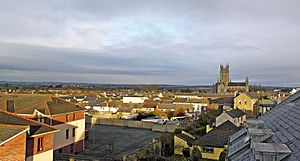
In 1609, King James I officially made Kilkenny a city. An old book from the 1600s described Kilkenny as a city on the River Nore, with two marble bridges. It mentioned the large St. Canice's Cathedral in the north and the strong castle in the south. The book said that both the church and the castle helped the city grow.
Today, Kilkenny is still called the City of Kilkenny or Kilkenny City.
Kilkenny During the Williamite War
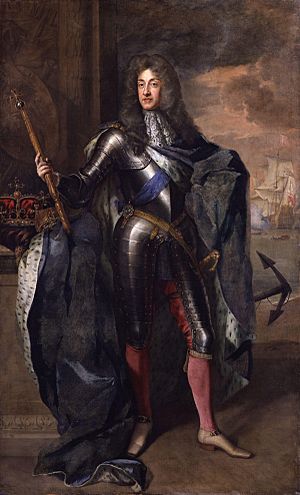
King of England, Scotland, and Ireland, who was removed from power by William in 1689. He was supported by the mainly Catholic "Jacobites" in Ireland.
James II of England was a king who favored Catholics. This caused a rebellion in England, and he had to flee to France. In 1689, James came to Ireland with help from French soldiers. He traveled through Kilkenny to Dublin. The Irish Parliament said James was still their King. They also took away the lands of Protestants who supported William of Orange, who was trying to take James's place.
James II stayed in Kilkenny Castle for most of the winter from November 1689 to January 1690. He tried to build an army in Ireland. However, he was defeated at the Battle of the Boyne in 1690 by William. After his defeat, James's army passed through Kilkenny and forced the people to pay money to stop the city from being looted. James then fled back to France and never returned to his kingdoms.
Kilkenny gave up to William's army without a fight. The wealthy Old English families who had supported James lost everything. William's army stayed near Kilkenny from October 1690 to May 1691.
In the late 1600s, James II had wanted to give religious freedom to all Catholics and Protestants in Ireland. He even tried to turn a Catholic college in Kilkenny into a university. But after James lost the Battle of the Boyne, the university had to close.
Modern Kilkenny
Kilkenny won its first big national hurling championship (All-Ireland Hurling Title) in 1904. A new church, John's Church, was built between 1903 and 1908. In 1904, King Edward VII and Queen Alexandra visited Kilkenny. Thousands of people filled the city to see them. The King said he cared deeply about the Irish people.
In 1917, W. T. Cosgrave won an election in Kilkenny for the Sinn Féin Party. In May 1922, before the Irish Civil War officially began, there was fighting in Kilkenny. Forces who were against the peace treaty took over the city center. Troops were sent from Dublin to remove them. On May 3, 18 men were reported killed in the fighting. To avoid a full civil war, both sides agreed to a truce.
Kilkenny Castle closed in 1935, and the Ormonde family, who owned it, left Ireland. The Kilkenny Design Workshops opened in 1965. In 1967, the Marquess of Ormonde gave Kilkenny Castle to the people of Kilkenny. Margaret Tynan became the first woman to be elected Mayor of Kilkenny.
In 2009, a new stamp was released to celebrate 400 years since Kilkenny became a city. The stamp shows Kilkenny Castle and St. John's Bridge. Also in 2009, Malcolm Noonan became the first Green Party mayor. The offices of the Heritage Council (Ireland) moved to Church Lane.
Today, Kilkenny is known for its lively cultural scene. It hosts annual events like the Kilkenny Arts Week Festival in August and the Cat Laughs Comedy Festival in June.


